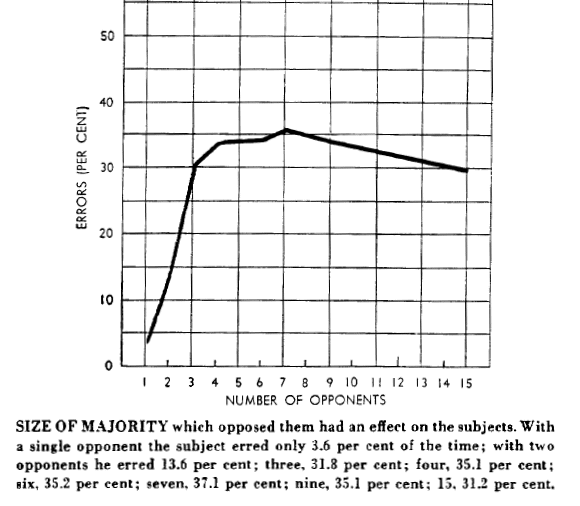Solomon Asch experiment (1958)
A study of conformity
Social Pressure and
Perception
Imagine yourself in the following situation: You sign up for
a psychology experiment, and on a specified date you and seven
others whom you think are also subjects arrive and are seated at a
table in a small room. You don't know it at the time, but the others
are actually associates of the experimenter, and their behavior has
been carefully scripted. You're the only real subject.
The experimenter arrives and tells you that the study in
which you are about to participate concerns people's visual
judgments. She places two cards before you. The card on the left
contains one vertical line. The card on the right displays three
lines of varying length.

The experimenter asks all of you, one at a time, to choose
which of the three lines on the right card matches the length of the
line on the left card. The task is repeated several times with
different cards. On some occasions the other "subjects" unanimously
choose the wrong line. It is clear to you that they are wrong, but
they have all given the same answer.
What would you do? Would you go along with the majority
opinion, or would you "stick to your guns" and trust your own eyes?
In 1951 social psychologist Solomon Asch devised this
experiment to examine the extent to which pressure from other people
could affect one's perceptions. In
total, about one third of the subjects who were placed in this
situation went along with the clearly erroneous majority.
Asch showed bars like those in the Figure to college
students in groups of 8 to 10. He told them he was studying visual
perception and that their task was to decide which of the bars on
the right was the same length as the one on the left. As you can
see, the task is simple, and the correct answer is obvious. Asch
asked the students to give their answers aloud. He repeated the
procedure with 18 sets of bars. Only one student in each group was
a real subject.
All the others were confederates who had been instructed to give two correct answers and then
to some incorrect answers on the remaining 'staged' trials. Asch arranged for the real
subject to be the next-to-the-last person in each group to announce
his answer so that he would hear most of the confederates incorrect
responses before giving his
own. Would he go along with the crowd?

Solomon Asch far right - real subject - third from right.
To Asch's surprise, 37 of the 50 subjects conformed themselves
to the 'obviously erroneous' answers given by the other group members at least once, and 14 of them conformed on more than
6 of the 'staged' trials. When faced with a unanimous wrong answer by the
other group members, the mean subject conformed on 4 of the 'staged'
trials.
Asch was disturbed by these results: "The tendency to
conformity in our society is so strong that reasonably intelligent
and well-meaning young people are willing to call white black. This
is a matter of concern. It raises questions about our ways of
education and about the values that guide our conduct."

Real subject leans forward to get a better view of the lines being displayed.
This particular individual insisted that "he has to call them as he sees them"
and disagreed with the consensus over each of 'staged' trials.
Why did the subjects conform so readily? When they
were interviewed after the experiment, most of them said that they
did not really believe their conforming answers, but had gone along
with the group for fear of being ridiculed or thought "peculiar." A
few of them said that they really did believe the group's answers
were correct.
Asch conducted a revised version of his experiment
to find out whether the subjects truly did not believe their
incorrect answers. When they were permitted to write down their
answers after hearing the answers of others, their level of
conformity declined to about one third what it had been in the
original experiment.
Apparently, people conform for two main reasons:
because they want to be liked by the group and because they believe
the group is better informed than they are. Suppose you go to a
fancy dinner party and notice to your dismay that there are four
forks beside your plate. When the first course arrives, you are not
sure which fork to use. If you are like most people, you look around
and use the fork everyone else is using. You do this because you
want to be accepted by the group and because you assume the others
know more about table etiquette than you do.
Conformity, group size, and cohesiveness
Asch found that one of the situational factors that
influence conformity is the size of the opposing majority. In a
series of studies he varied the number of confederates who gave
incorrect answers from 1 to 15.

The subjects' responses varied with the level of 'majority opinion' they were faced with.
He found that the subjects conformed to a group of 3 or 4 as readily as they did to a larger group.
However, the subjects conformed much less if they had an
"ally" In some of his experiments, Asch instructed one of the
confederates to give correct answers. In the presence of this
nonconformist, the real subjects conformed only one fourth as much
as they did in the original experiment. There were several reasons:
First, the real subject observed that the majority did not ridicule
the dissenter for his answers. Second, the dissenter's answers made
the subject more certain that the majority was wrong. Third, the
real subject now experienced social pressure from the dissenter as
well as from the majority. Many of the real subjects later reported
that they wanted to be like their nonconformist partner (the
similarity principle again). Apparently, it is difficult to be a
minority of one but not so difficult to be part of a minority of
two.
Some of the subjects indicated afterward that they assumed
the rest of the people were correct and that their own perceptions
were wrong. Others knew they were correct but didn't want to be
different from the rest of the group. Some even insisted they saw
the line lengths as the majority claimed to see them.
Asch concluded that it is difficult to maintain that you see
something when no one else does. The group pressure implied by the expressed
opinion of other people can lead to modification and distortion effectively making
you see almost anything.
Human Psychology

It is widely known that Plato, pupil of and close friend to Socrates, accepted that Human
Beings have a " Tripartite Soul " where individual Human Psychology is composed of three aspects -
Wisdom-Rationality, Spirited-Will and Appetite-Desire.
What is less widely appreciated is that such major World Faiths as Christianity, Islam,
Hinduism and Buddhism see "Spirituality" as being relative to "Desire" and to "Wrath".
|
![[Asch conformity experiment]](../enlightenment.gif)
![[Asch conformity experiment]](../enlightenment.gif)